Want to Branch Out with Some Jazz Fusion? Learn Oz Noy’s Harmonically Inventive “She’s Not There” Solo
Retrace the jazz fusion master’s instrumental version of the Zombies’ 1964 classic here.

As one of today’s most innovative and creative jazz fusion guitarists, Israeli-born Oz Noy has developed an exciting playing style by blending the sophistication of jazz with the raw energy of rock, funk and blues guitar.
In this lesson, we’ll look at Oz’s solo in his instrumental cover of the mid-’60s classic “She’s Not There” by the Zombies.
This funky and evocative arrangement appears on his 2020 release Snapdragon and showcases his creative and highly appealing jazz fusion-style soloing on a simple pop chord progression. The solo is played in the key of A minor, and while the majority of it is blues based, there are plenty of harmonically inventive twists and turns along the way.
The transcription presented herein spans the entire solo, which is 32 bars long and begins at 2:38 on the recording.
The chord progression over which Noy solos is based on the verse and pre-chorus sections from the original Zombies version of the song and follows a repeating 16-bar form, or “chorus,” that consists of an eight-bar “A” section followed by an eight-bar “B” section.
It’s a good idea to take a look at the chords above the staff and familiarize yourself with the entire progression before digging into the solo, as this will help you get a handle on the overall form and better appreciate Noy’s harmonic-melodic thinking.
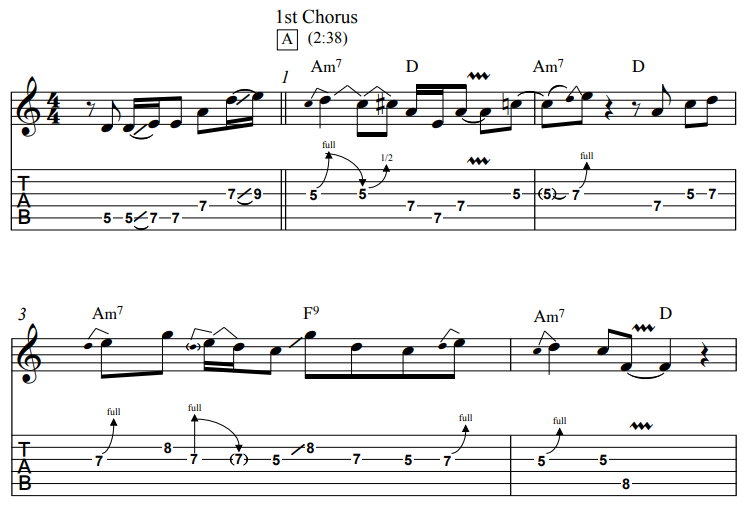
Oz begins the solo with some bluesy phrases based on the A minor pentatonic scale (A, C, D, E, G) and played over a i-IV A Dorian vamp (Am to D).
He starts out simply and peppers his lines with some sassy string bends, creating an alluring vibe.
In bar 4 the guitarist plays an unexpected F natural note over a D chord, which implies a D minor sound (D, F, A) over the D major tonality (D, F#, A). A simple explanation for this is that he’s adding an F note from the parallel A Aeolian mode (A, B, C, D, E, F, G) to create melodic tension.
In fact, throughout the solo we’ll encounter additional examples of Oz’s use of different A minor scales and see how he combines them to create a kind of A minor “gumbo.”

Another device that will come up often in this solo involves Noy’s superimposition of scale or arpeggio tones that imply either a major or dominant 7th sound over a minor chord with the same root.
For example, take a look at bar 6, where he plays a C# note over Am. The C# describes an A major sound (A, C#, E), which is the V (five) chord of the D chord that follows. In so doing, he implies the sound of a V - I cadence – A to D instead of Am to D.
While this move seems to break an important musical “rule” – namely, Thou shalt not play a major 3rd over a minor chord – it builds exciting harmonic tension when used in this way.

As we approach the end of the first “A” section, take a look at bar 7, beat 4, where Oz plays a line that implies an altered-dominant E7#5b5 sound, which carries over to the first beat of bar 8.
You may be wondering why the implied E7 altered tonality works over the F9 chord in the progression. The answer is mainly due to the fact that both chords serve to build harmonic tension that resolves satisfyingly on the A7 chord.
The E7 altered-dominant line is therefore justified by the fact that it implies a V - I cadence to A7. In fact, by carrying the E7 sound over the bar line into bar 8, Oz creates even more tension with a delayed resolution to A7. It’s all about building that extra drama!
In bar 8, Oz plays a cool jazz lick over the A7 chord using notes from the eight-tone A bebop-dominant scale (A, B, C#, D, E, F#, G, G#) with an added b9, Bb. The dominant sound of the scale and the added b9 combine to create a compelling cadence to the D major chord in bar 9, resulting in a smooth transition to the first “B” section of the progression.

Noy begins this next section of his solo by playing an interesting angular motif that he develops over the chord changes D - Dm - Am.
Notice how the line jumps back and forth between high and low registers, creating two separate melodic paths and evoking a “call-and-response” phrasing structure.
The lower part of the line begins with an F# note, which is the 3rd of the D major chord, and moves to F, which is the minor, or “flat,” 3rd (b3) of Dm, before landing on E, the 5th of Am.
The higher part of the line moves from E, the 9th of both the D major and D minor chords, to the D root note, then down to C, the b3 of Am.
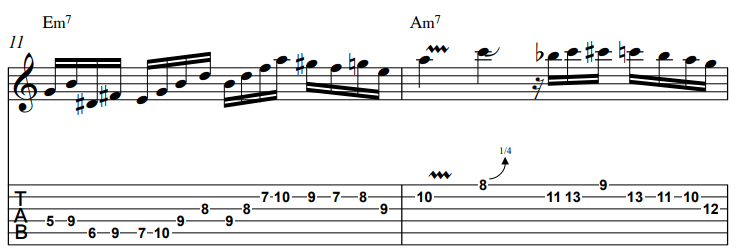
The lick at bar 11 is played over an Em chord and illustrates Oz’s use of the E harmonic minor scale (E, F#, G, A, B, C, D#), which encompasses the chords and arpeggios for D# diminished (D#dim: D#, F#, A) and B7 (B, D#, F#, A).
Notice how the guitarist weaves both of these arpeggios into his melodic line, creating tension and an interesting contour.
After outlining the B7 arpeggio on beat 3 of bar 11, Noy plays a chromatic line that includes both the major and minor 3rds of E – G# and G, respectively.
This effectively describes the sound of an E7#9 chord (E, G#, B, D, G) and is another example of superimposing a dominant 7-type sound over a minor chord in order to create a strong V - I cadence to the chord that follows.
In bar 12, we see another example of this approach, this time with an A7b9#9 sound, which Oz imposes over the Am chord.
The b9 and #9 extensions (Bb and C, respectively) decorate the A7 chord tones (A, C# and G), resulting in an A altered-dominant sound that creates a strong push to the D chord that follows in bar 13.
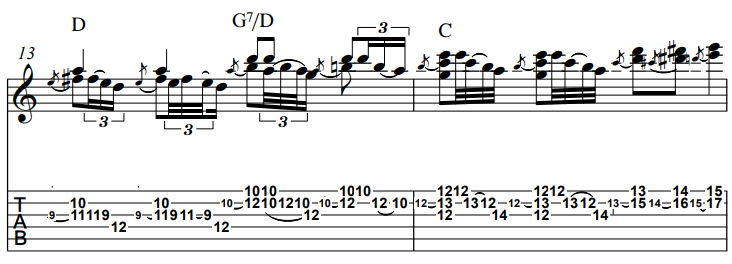
Next, let’s check out Oz’s tasteful and soulful-sounding use of double-stops with oblique hammer-ons and pull-offs, in bars 13 and 14.
This is a cool “rhythm-lead” technique popularized by players such as Jimi Hendrix on songs like “Little Wing” and “Castles Made of Sand.”
Noy begins with a double-stop phrase that elegantly embellishes a D major chord followed by similar phrases that likewise outline the chords G and C.
He concludes the lick with an ascending sequence of double-stops that leads chromatically to the E7 chord in bar 15.
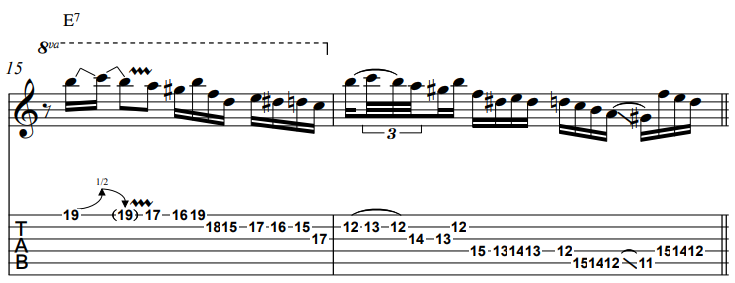
In the final two bars of his first solo chorus (bars 15 and 16), Oz crafts a cascading single-note line using notes from the E Phrygian-dominant mode (E, F, G#, A, B, C, D), with an added D# passing tone that he uses, along with F, to melodically bookend the targeted E root note.
Notice how the F note imparts a b9 sound to the backing E7 chord and that the D# also creates descending chromatic movement between the E root and the b7 (D), similar to what we would see in an E bebop scale.
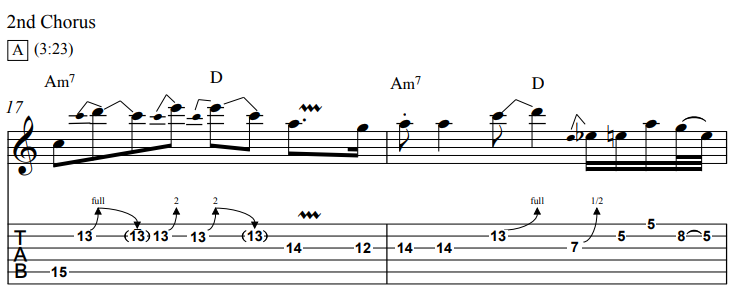
Noy begins his second solo chorus (at bar 17) in the same manner as the first – with some cool A minor pentatonic and blues scale-type ideas.
Notice his expressive use of the extra-wide string bends that span two whole steps, from C to E.

Things get jazzy when we get to the F9 chord in the second half of bar 19, with a lick based on the F bebop-dominant scale (F, G, A, Bb, C, D, Eb, E). Notice that this scale is identical to the F Mixolydian mode (F, G, A, Bb, C, D, Eb) but there is an additional E natural chromatic passing tone between Eb and F, which creates a b7 - 7 - root motion.
In bar 20, Oz constructs an interesting motif based on an arpeggio in a seven-note sequence. The first seven notes outline an A minor arpeggio with an added 11th (D), and in the second half of the bar the guitarist plays a similar seven-note sequence but up an octave and a half step.
The notes Bb, E, Eb and Ab in beats 3 and 4 are all native to the Bb blues scale (Bb, Db, Eb, E, F, Ab), which means we have momentarily shifted up a semitone, or half step, from our home tonality of A.
This kind of chromatic shift – where an idea is first played in the home key then followed by a similar idea played up or down a half step – is sometimes referred to as “sidestepping,” and it offers a simple and musically intriguing way to play “outside” lines.
Sidestepping tends to work best when both the “outside” and “inside” phrases share a similar rhythm, much like what we see here in bar 20.
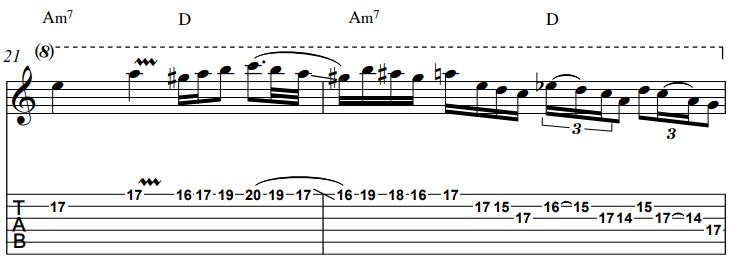
Noy introduces another shade of A minor in bars 21 and 22, with a line based on the A harmonic minor scale (A, B, C, D, E, F, G#).
Like the A blues scale (A, C, D, Eb, E, G) and A Dorian mode (A, B, C, D, E, F#, G), this note set serves as yet another musical ingredient in our previously mentioned A minor “gumbo.”
Observe how the A# (Bb) passing tone creates some interesting chromaticism on the first beat of bar 22. Here, Oz approaches the A on beat 2 by first playing a note a half step above followed by a note a half step below.
This is an example of a melodic device known as enclosure, which is a common technique used in bebop music, where “chromatic neighbor” pitches surround and precede a targeted note.

In bars 22 and 23, Oz introduces a motif that consists of a repeating triplet rhythm paired with a descending A minor pentatonic-based sequence. Check out the rhythmic and melodic similarities on each beat in the overall phrase.
We recommend experimenting with creating patterns like this on your own, by picking a repeating rhythm and scale sequence to create long ascending or descending lines.
In bar 24, Oz approaches the end of the second “A” section with a line that implies an A7b9 sound on the A7 chord via the use of the A half-whole diminished scale (A, Bb, C, C#, D# [Eb], E, F#, G).
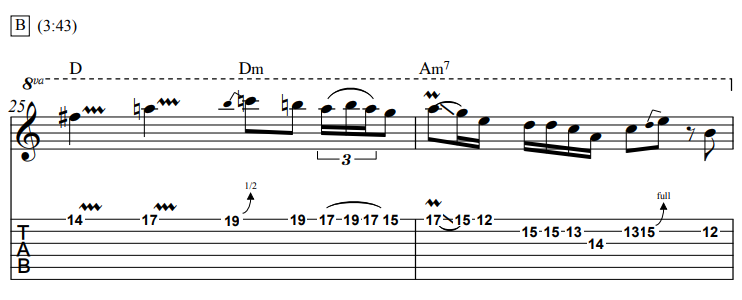
The tension created from the half-whole diminished lick resolves to F# on the D major chord at the start of bar 25. Since the note F# is the 3rd of the D chord and lands on the bar’s first beat, it helps to create a solid resolution and a clear transition into the final “B” section.
Noy addresses the Am and Em chords in bars 26 and 27 with their respective minor pentatonic scales. By playing A minor pentatonic over Am and E minor pentatonic on the Em chord, he creates a feeling of continuity by outlining the vertical harmony on each chord.
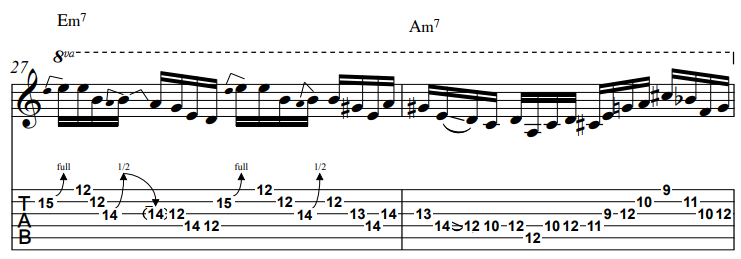
At the end of bar 27, notice Oz’s use of the G# note, which suggests an E major sound over the Em chord in the progression. This is similar to what we saw in bar 6, where the guitarist implied a V - I cadence with a major V chord instead of a minor one.
Notice here that he hits the G# note again on the downbeat of bar 28, this time implying a natural 7 on the A minor chord, resulting in an Am-maj7 sound (A, C, E, G#).
Oz gets fancy again in the second half of this bar, where he slips in an A7b9#5 arpeggio, which functions as the V7 of the D chord in the next bar. Once again, he’s implied a dominant sound on a minor chord to create a stronger V - I cadence to the chord that follows.
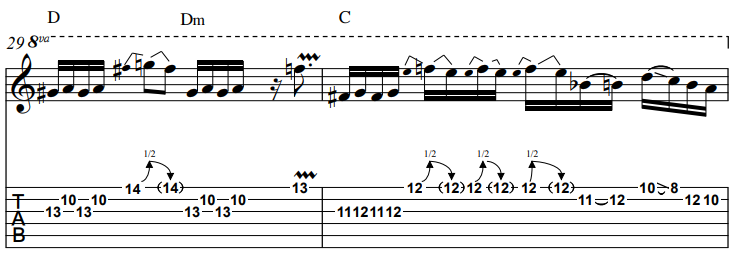
Using common tones between chords is a great way to create smooth, cohesive lines in your solos.
Oz demonstrates the use of this device in bar 29 over the D and Dm chords with two three-note sequences that share the notes A and G# (Ab).
The first sequence moves from G# to A to F# on the D chord and follows with G# - A - F on Dm. The G# (Ab) note functions as the #11 on the D chord and b5 on Dm, and the A note is the 5th of both chords.
As we near the end of the solo, we encounter another example of Oz’s application of one of the bebop scales.
Have a look at the second half of bar 30, where the guitarist plays notes from the C bebop-dominant scale (C, D, E, F, G, A, Bb, B) over the C chord to create a line that tastefully resolves to the E7 chord in bar 31. Notice how he employs the scale’s B passing tone to create chromaticism within the line.
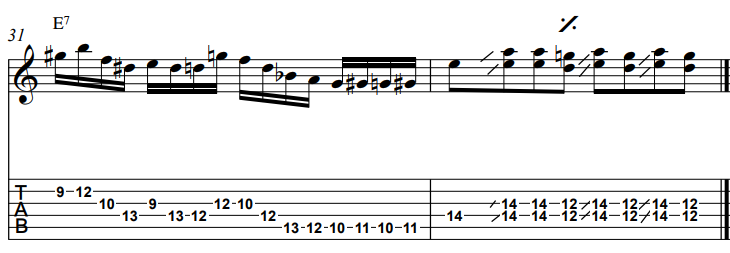
As the solo comes to a close, Noy plays a cool lick in the second-to-last bar that combines notes from the E half-whole diminished scale (E, F, G, G#, Bb, B, C#, D) with the chromatic passing tones D# and A.
The additional passing tones present another example of the melodic enclosure technique, this time by chromatically surrounding the root note, E, and major 3rd, G#.
Oz concludes with a sliding-4ths double-stop lick borrowed from the melody, making for a smooth transition out of the solo.
When studying this solo, we highly recommend recording the chords or using a looper, in order to play and hear the single-note lines in their harmonic context.
As always, have a listen to the recording, and, while you’re at it, check out the entire Snapdragon album for more imaginative and inspired electric guitar playing and writing.
Buy Oz Noy’s Snapdragon here.
Get The Pick Newsletter
All the latest guitar news, interviews, lessons, reviews, deals and more, direct to your inbox!
“Write for five minutes a day. I mean, who can’t manage that?” Mike Stern's top five guitar tips include one simple fix to help you develop your personal guitar style
"It’s like you’re making a statement. And you never know where it’ll lead." Pete Thorn shares the tip that convinced Joe Satriani he was the right guitarist for the SatchVai Band










